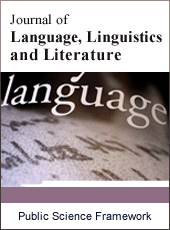Journal of Language, Linguistics and Literature
Articles Information
Journal of Language, Linguistics and Literature, Vol.2, No.4, Aug. 2016, Pub. Date: Sep. 3, 2016
SMS Code-Switching Among Teenagers in Jordan
Pages: 32-39 Views: 5809 Downloads: 1561
[01]
Ruba A. Mustafa, Royal Commission for Jubail and Yanbu, Faculty of Arts, Department of English language and literature, Jubail University Collage, Jubail, KSA.
This study examines the phenomenon of SMS code-switching among teenagers in Jordan. It aims at investigating the most frequently used phrases in teenagers code-switched SMS and the reasons behind switching either to English or Arabic while texting. It also aims at exploring the factors that help in the spread of the use of code-switched SMS along with teenagers’ attitudes toward this phenomenon. A sample of 150 male and female teenagers, whose ages range between (13-17) were selected from five different private and public schools. A corpus of 1500 text messages was collected from the subjects. Methodology used in this study is descriptive and analytic. A questionnaire was designed and handed to the subjects along with an interview form that was designed to fulfill the objectives set for the study. Major findings of the current study revealed seven main reasons behind teenagers’ switched SMSes. It also explored four positive attitudes toward switching when texting and one negative attitude toward this phenomenon. It proved five factors that help in the spread of the use of code-switched SMS. It also shed light on the emergence of Arabizi and the reasons behind switching to Arabizi rather than Arabic or English.
Arabizi, Code-Switching, Switched-Sms, Texting
[01]
Al-Khatib, M. & Enaq Sabbah (2008) Language Choice in Mobile Text Messages among Jordanian University. SKY Journal of Linguistics, 21: 1-27.
[02]
Al-Khatib, M. & Farghal, M. (1999). English Borrowings in Jordanian Arabic: Distribution, Functions, and Attitudes. Grazer Linguistische Studien, 52: 1-18.
[03]
Adendorff, Ralph (1996) the functions of code-switching among high school teachers and students in KwaZulu and implications for teacher education. In Kathleen Baily & David Nunan (eds), voices from the language classroom: qualitative research in second language education, pp. 388-406. Cambrudge: Cambridge University Press.
[04]
Baron, Naomi, Lauren Squires, Sarah Tench & Marshall Thompson (2005) Tetgered or mobile? Use of a way messages in instant messaging by American college students in Richard Ling & Per Pedersen (eds), Mobile Communications: Renegotiation of the social sphere, pp. 293-311. london Springer –Verlag.
[05]
Benitez, Sandra (2008) The Effect of Bilingualism on Text Messaging Efficiency. Online: http//www.csudh.edu/psych/Sandra.
[06]
Craig, D. (2003). Instant Messaging: The Language of Youth Literacy. In The Boothe Prize Essays [Essay]. pp. 116 – 133).
[07]
Crystal, David (1998) English as aglobale language. Cambridge: Cambridge University Press.
[08]
Durham, Mercedes (2003) Language choice on a swiss mailing list. Journal of Computer-mediated Comunication 9 (1). Online: http://jcmc.indiana.edu/vol9/issue1/oliveira.html
[09]
Halmari, Helena (1997) Government and Codeswitching: Explaining American Finnish. Amsterdam & Philadelphi: Binjamins.
[10]
Lobet-Maris, Claire (2003) Mobile phone tribes:Y outh and social identity. In Leopoldina Fortunati, James E. Katz & Raimonda Riccini (eds.), Meditating the Human Body: Technology, Communication, and Fashion, pp. 87 92. Mahwah, New Jersey: Lawrence Erlbaum.
[11]
Mustafa, Zahra & Al-Khatib, Mahmoud (1994) Code-mixing of Arabic and English in teaching science. World Englishes13–2: 215.

ISSN Print: 2381-7054
ISSN Online: 2381-7062
Current Issue:
Vol. 6, Issue 1, March Submit a Manuscript Join Editorial Board Join Reviewer Team
ISSN Online: 2381-7062
Current Issue:
Vol. 6, Issue 1, March Submit a Manuscript Join Editorial Board Join Reviewer Team
| About This Journal |
| All Issues |
| Open Access |
| Indexing |
| Payment Information |
| Author Guidelines |
| Review Process |
| Publication Ethics |
| Editorial Board |
| Peer Reviewers |


